Long-Term Study of the Effects of Environment, Variety, and Fertilisation on Yield and Stability of Spring Barley Grain
Abstract
:1. Introduction
2. Results
2.1. Temperature, Sunshine Duration, and Precipitation during Long-Term Field Trials
2.2. Grain Yield Development and the Effect of Fertilisation
2.3. Relationship between Grain Yield and Weather
2.4. Yield Stability of Spring Barley
3. Discussion
3.1. Development of Weather at the Site of the Long-Term Trial
3.2. Influence of Weather on Grain Yield during the Long-Term Trial
3.3. Influence of Fertilization and Yield Stability of Spring Barley
4. Materials and Methods
4.1. Field Trial Description
4.2. Data Analysis
5. Conclusions
- (i).
- Trends for mean, minimal and maximal temperatures are on the rise, confirming a warming trend. The duration of sunshine is also increasing. While annual precipitation does not show significant changes at the long-term experiment site, the distribution of precipitation is gradually shifting towards greater irregularity in the first and second quarters of the year. Factors such as June rainfall, minimum temperature in July, and the length of sunshine in May significantly influence barley grain yields.
- (ii).
- The application of manure to the preceding crop positively affects barley grain yield. Mineral fertiliser application results in the highest yields. The linear–plateau model indicates that applying 55 kg ha−1 of nitrogen produces an optimal yield of 6.7 t ha−1.
- (iii).
- Moderate fertilisation was most stable for grain production, while the unfertilised Control, farmyard manure (FYM), and the highest mineral fertiliser doses exhibited more significant inter-annual yield fluctuations.
Author Contributions
Funding
Data Availability Statement
Acknowledgments
Conflicts of Interest
References
- Gardi, M.W.; Haussmann, B.I.G.; Malik, W.A.; Högy, P. Effects of Elevated Atmospheric CO2 and Its Interaction with Temperature and Nitrogen on Yield of Barley (Hordeum vulgare L.): A Meta-Analysis. Plant Soil 2022, 475, 535–550. [Google Scholar] [CrossRef]
- Yiğit, A.; Chmielewski, F.-M. A Deeper Insight into the Yield Formation of Winter and Spring Barley in Relation to Weather and Climate Variability. Agronomy 2024, 14, 1503. [Google Scholar] [CrossRef]
- Bento, V.A.; Ribeiro, A.F.S.; Russo, A.; Gouveia, C.M.; Cardoso, R.M.; Soares, P.M.M. The Impact of Climate Change in Wheat and Barley Yields in the Iberian Peninsula. Sci. Rep. 2021, 11, 15484. [Google Scholar] [CrossRef]
- Mansour, E.; Moustafa, E.S.A.; Qabil, N.; Abdelsalam, A.; Wafa, H.A.; El Kenawy, A.; Casas, A.M.; Igartua, E. Assessing Different Barley Growth Habits under Egyptian Conditions for Enhancing Resilience to Climate Change. Field Crops Res. 2018, 224, 67–75. [Google Scholar] [CrossRef]
- Högy, P.; Poll, C.; Marhan, S.; Kandeler, E.; Fangmeier, A. Impacts of Temperature Increase and Change in Precipitation Pattern on Crop Yield and Yield Quality of Barley. Food Chem. 2013, 136, 1470–1477. [Google Scholar] [CrossRef]
- Cammarano, D.; Zierden, D.; Stefanova, L.; Asseng, S.; O’Brien, J.J.; Jones, J.W. Using Historical Climate Observations to Understand Future Climate Change Crop Yield Impacts in the Southeastern US. Clim. Chang. 2016, 134, 311–326. [Google Scholar] [CrossRef]
- Cammarano, D.; Hawes, C.; Squire, G.; Holland, J.; Rivington, M.; Murgia, T.; Roggero, P.P.; Fontana, F.; Casa, R.; Ronga, D. Rainfall and Temperature Impacts on Barley (Hordeum vulgare L.) Yield and Malting Quality in Scotland. Field Crops Res. 2019, 241, 107559. [Google Scholar] [CrossRef]
- Schierhorn, F.; Hofmann, M.; Adrian, I.; Bobojonov, I.; Müller, D. Spatially Varying Impacts of Climate Change on Wheat and Barley Yields in Kazakhstan. J. Arid Environ. 2020, 178, 104164. [Google Scholar] [CrossRef]
- Ishikawa, S.; Nakashima, T.; Hare, M.C.; Kettlewell, P.S. A Common Climate–Yield Relationship for Wheat and Barley in Japan and the United Kingdom. Climate 2024, 12, 125. [Google Scholar] [CrossRef]
- Hakala, K.; Jauhiainen, L.; Rajala, A.A.; Jalli, M.; Kujala, M.; Laine, A. Different Responses to Weather Events May Change the Cultivation Balance of Spring Barley and Oats in the Future. Field Crops Res. 2020, 259, 107956. [Google Scholar] [CrossRef]
- Trnka, M.; Dubrovský, M.; Žalud, Z. Climate Change Impacts and Adaptation Strategies in Spring Barley Production in the Czech Republic. Clim. Chang. 2004, 64, 227–255. [Google Scholar] [CrossRef]
- Sabitova, A.; Suleımanova, G.; Kizildeniz, T.; Yetik, A.K. Modeling Climate Change Scenarios for Spring Barley in Southeast of Almaty in Kazakhstan Using the LINTUL Approach. Black Sea J. Eng. Sci. 2024, 7, 465–472. [Google Scholar] [CrossRef]
- Addy, J.W.G.; Ellis, R.H.; Macdonald, A.J.; Semenov, M.A.; Mead, A. Investigating the Effects of Inter-Annual Weather Variation (1968–2016) on the Functional Response of Cereal Grain Yield to Applied Nitrogen, Using Data from the Rothamsted Long-Term Experiments. Agric. For. Meteorol. 2020, 284, 107898. [Google Scholar] [CrossRef]
- Thai, T.H.; Bellingrath-Kimura, S.D.; Hoffmann, C.; Barkusky, D. Effect of Long-Term Fertiliser Regimes and Weather on Spring Barley Yields in Sandy Soil in North-East Germany. Arch. Agron. Soil Sci. 2020, 66, 1812–1826. [Google Scholar] [CrossRef]
- Hlisnikovský, L.; Křížová, K.; Menšík, L.; Kunzová, E. How Mineral Fertilization and Soil-Climate Conditions Affect Spring Barley Grain Yield and Soil Chemical Properties. Agronomy 2021, 11, 1843. [Google Scholar] [CrossRef]
- Czech Statistical Office Final Harvest Figures—2023. Available online: https://www.czso.cz/csu/czso/final-harvest-figures-2023 (accessed on 4 May 2024).
- Jaeger, A.; Zannini, E.; Sahin, A.W.; Arendt, E.K. Barley Protein Properties, Extraction and Applications, with a Focus on Brewers’ Spent Grain Protein. Foods 2021, 10, 1389. [Google Scholar] [CrossRef]
- Potterton, E.M.; McCabe, T. The Effect of Sowing Date and Nitrogen Rate on the Grain Yield, Grain Quality and Malt Analyses of Spring Malting Barley for Distilling in Ireland. J. Agric. Sci. 2018, 156, 515–527. [Google Scholar] [CrossRef]
- Křen, J.; Klem, K.; Svobodová, I.; Míša, P.; Lukas, V. Influence of Sowing, Nitrogen Nutrition and Weather Conditions on Stand Structure and Yield of Spring Barley. Cereal Res. Commun. 2015, 43, 326–335. [Google Scholar] [CrossRef]
- Lobell, D.B.; Field, C.B. Global Scale Climate-Crop Yield Relationships and the Impacts of Recent Warming. Environ. Res. Lett. 2007, 2, 014002. [Google Scholar] [CrossRef]
- Xie, W.; Xiong, W.; Pan, J.; Ali, T.; Cui, Q.; Guan, D.; Meng, J.; Mueller, N.D.; Lin, E.; Davis, S.J. Decreases in Global Beer Supply Due to Extreme Drought and Heat. Nat. Plants 2018, 4, 964–973. [Google Scholar] [CrossRef] [PubMed]
- Kim, Y.G.; Park, H.H.; Lee, H.J.; Kim, H.K.; Kuk, Y.I. Growth, Yield, and Grain Quality of Barley (Hordeum vulgare L.) Grown across South Korean Farmlands with Different Temperature Distributions. Agronomy 2022, 12, 2731. [Google Scholar] [CrossRef]
- Achli, S.; Epule, T.E.; Dhiba, D.; Salih, W.; Chehbouni, A. Vulnerability of Maize, Barley, and Wheat Yields to Growing Season Temperature and Socioeconomic Indicators in Morocco. J. Water Clim. Chang. 2024, 15, 1588–1611. [Google Scholar] [CrossRef]
- Olšovská, K.; Sytar, O.; Kováčik, P. Optimizing Nitrogen Application for Enhanced Barley Resilience: A Comprehensive Study on Drought Stress and Nitrogen Supply for Sustainable Agriculture. Sustainability 2024, 16, 2016. [Google Scholar] [CrossRef]
- Reineke, T.; Steffens, D. Phosphorus Requirement of Barley and Wheat for Seed and Food Quality. Plant Soil Environ. 2022, 68, 459–465. [Google Scholar] [CrossRef]
- Frei, J.; Wiesenberg, G.L.B.; Hirte, J. The Impact of Climate and Potassium Nutrition on Crop Yields: Insights from a 30-Year Swiss Long-Term Fertilization Experiment. Agric. Ecosyst. Environ. 2024, 372, 109100. [Google Scholar] [CrossRef]
- Kozera, W.; Barczak, B.; Knapowski, T.; Spychaj-Fabisiak, E.; Murawska, B. Reaction of Spring Barley to NPK and S Fertilization. Yield, the Content of Macroelements and the Value of Ionic Ratios. Rom. Agric. Res. 2017, 34, 275–285. [Google Scholar]
- Dostálová, Y.; Hřivna, L.; Kotková, B.; Burešová, I.; Janečková, M.; Šottníková, V. Effect of Nitrogen and Sulphur Fertilization on the Quality of Barley Protein. Plant Soil Environ. 2015, 61, 399–404. [Google Scholar] [CrossRef]
- Panfilova, A.; Gamayunova, V.; Potryvaieva, N. The Impact of Nutrition Optimization on Crop Yield and Grain Quality of Spring Barley Varieties (Hordeum vulgare L.). Agraarteadus 2021, 32, 111–116. [Google Scholar] [CrossRef]
- Stevens, W.B.; Sainju, U.M.; Caesar-TonThat, T.; Iversen, W.M. Malt Barley Yield and Quality Affected by Irrigation, Tillage, Crop Rotation, and Nitrogen Fertilisation. Agron. J. 2015, 107, 2107–2119. [Google Scholar] [CrossRef]
- Stadnik, B.; Tobiasz-Salach, R.; Migut, D. Influence of Foliar Application of Microelements on Yield and Yield Components of Spring Malting Barley. Agriculture 2024, 14, 505. [Google Scholar] [CrossRef]
- Hofer, K.; Barmeier, G.; Schmidhalter, U.; Habler, K.; Rychlik, M.; Hückelhoven, R.; Hess, M. Effect of Nitrogen Fertilization on Fusarium Head Blight in Spring Barley. Crop Prot. 2016, 88, 18–27. [Google Scholar] [CrossRef]
- Krček, M.; Slamka, P.; Olšovská, K.; Brestič, M.; Benčíková, M. Reduction of Drought Stress Effect in Spring Barley (Hordeum vulgare L.) by Nitrogen Fertilization. Plant Soil Environ. 2008, 54, 7–13. [Google Scholar] [CrossRef]
- O’Donovan, J.T.; Turkington, T.K.; Edney, M.J.; Clayton, G.W.; McKenzie, R.H.; Juskiw, P.E.; Lafond, G.P.; Grant, C.A.; Brandt, S.; Harker, K.N.; et al. Seeding Rate, Nitrogen Rate, and Cultivar Effects on Malting Barley Production. Agron. J. 2011, 103, 709–716. [Google Scholar] [CrossRef]
- Shrestha, R.K.; Lindsey, L.E. Agronomic Management of Malting Barley and Research Needs to Meet Demand by the Craft Brew Industry. Agron. J. 2019, 111, 1570–1580. [Google Scholar] [CrossRef]
- Smoczynska, A.; Pacak, A.; Grabowska, A.; Bielewicz, D.; Zadworny, M.; Singh, K.; Dolata, J.; Bajczyk, M.; Nuc, P.; Kesy, J.; et al. Excess Nitrogen Responsive HvMADS27 Transcription Factor Controls Barley Root Architecture by Regulating Abscisic Acid Level. Front. Plant Sci. 2022, 13, 950796. [Google Scholar] [CrossRef] [PubMed]
- Kong, L.; Xie, Y.; Hu, L.; Si, J.; Wang, Z. Excessive Nitrogen Application Dampens Antioxidant Capacity and Grain Filling in Wheat as Revealed by Metabolic and Physiological Analyses. Sci. Rep. 2017, 7, 43363. [Google Scholar] [CrossRef]
- Tyagi, J.; Ahmad, S.; Malik, M. Nitrogenous Fertilizers: Impact on Environment Sustainability, Mitigation Strategies, and Challenges. Int. J. Environ. Sci. Technol. 2022, 19, 11649–11672. [Google Scholar] [CrossRef]
- Chen, J.; Lü, S.; Zhang, Z.; Zhao, X.; Li, X.; Ning, P.; Liu, M. Environmentally Friendly Fertilisers: A Review of Materials Used and Their Effects on the Environment. Sci. Total Environ. 2018, 613–614, 829–839. [Google Scholar] [CrossRef]
- Singh, B. Are Nitrogen Fertilisers Deleterious to Soil Health? Agronomy 2018, 8, 48. [Google Scholar] [CrossRef]
- Balafoutis, A.; Beck, B.; Fountas, S.; Vangeyte, J.; Van Der Wal, T.; Soto, I.; Gómez-Barbero, M.; Barnes, A.; Eory, V. Precision Agriculture Technologies Positively Contributing to Ghg Emissions Mitigation, Farm Productivity and Economics. Sustainability 2017, 9, 1339. [Google Scholar] [CrossRef]
- Macholdt, J.; Honermeier, B. Yield Stability in Winter Wheat Production: A Survey on German Farmers’ and Advisors’ Views. Agronomy 2017, 7, 45. [Google Scholar] [CrossRef]
- Hlisnikovský, L.; Ivičic, P.; Barłóg, P.; Grzebisz, W.; Menšík, L.; Kunzová, E. The Effects of Weather and Fertilisation on Grain Yield and Stability of Winter Wheat Growing on Orthic Luvisol—Analysis of Long-Term Field Experiment. Plants 2022, 11, 1825. [Google Scholar] [CrossRef] [PubMed]
- Chmielewski, F.M.; Köhn, W. Impact of Weather on Yield Components of Spring Cereals over 30 Years. Agric. For. Meteorol. 1999, 96, 49–58. [Google Scholar] [CrossRef]
- Mozny, M.; Hajkova, L.; Vlach, V.; Ouskova, V.; Musilova, A. Changing Climatic Conditions in Czechia Require Adaptation Measures in Agriculture. Climate 2023, 11, 210. [Google Scholar] [CrossRef]
- Twardosz, R.; Walanus, A.; Guzik, I. Warming in Europe: Recent Trends in Annual and Seasonal Temperatures. Pure Appl. Geophys. 2021, 178, 4021–4032. [Google Scholar] [CrossRef]
- Hemmerle, H.; Bayer, P. Climate Change Yields Groundwater Warming in Bavaria, Germany. Front. Earth Sci. 2020, 8, 575894. [Google Scholar] [CrossRef]
- Sujetoviene, G.; Velička, R.; Kanapickas, A.; Kriaučiuniene, Z.; Romanovskaja, D.; Bakšiene, E.; Vagusevičiene, I.; Klepeckas, M.; Juknys, R. Climate-Change-Related Long-Term Historical and Projected Changes to Spring Barley Phenological Development in Lithuania. J. Agric. Sci. 2018, 156, 1061–1069. [Google Scholar] [CrossRef]
- Daničić, M.; Zekić, V.; Mirosavljević, M.; Lalić, B.; Putnik-Delić, M.; Maksimović, I.; Marta, A.D. The Response of Spring Barley (Hordeum vulgare L.) to Climate Change in Northern Serbia. Atmosphere 2019, 10, 14. [Google Scholar] [CrossRef]
- Szwed, M. Variability of Precipitation in Poland under Climate Change. Theor. Appl. Climatol. 2019, 135, 1003–1015. [Google Scholar] [CrossRef]
- Olesen, J.E.; Trnka, M.; Kersebaum, K.C.; Skjelvåg, A.O.; Seguin, B.; Peltonen-Sainio, P.; Rossi, F.; Kozyra, J.; Micale, F. Impacts and Adaptation of European Crop Production Systems to Climate Change. Eur. J. Agron. 2011, 34, 96–112. [Google Scholar] [CrossRef]
- Zhang, K.; Yao, Y.; Qian, X.; Wang, J. Various Characteristics of Precipitation Concentration Index and Its Cause Analysis in China between 1960 and 2016. Int. J. Climatol. 2019, 39, 4648–4658. [Google Scholar] [CrossRef]
- Zamani, R.; Mirabbasi, R.; Nazeri, M.; Meshram, S.G.; Ahmadi, F. Spatio-Temporal Analysis of Daily, Seasonal and Annual Precipitation Concentration in Jharkhand State, India. Stoch. Environ. Res. Risk Assess. 2018, 32, 1085–1097. [Google Scholar] [CrossRef]
- Degirmendžić, J.; Kozuchowski, K.; Zmudzka, E. Changes of Air Temperature and Precipitation in Poland in the Period 1951-2000 and Their Relationship to Atmospheric Circulation. Int. J. Climatol. 2004, 24, 291–310. [Google Scholar] [CrossRef]
- Brázdil, R.; Zahradníček, P.; Dobrovolný, P.; Řehoř, J.; Trnka, M.; Lhotka, O.; Štěpánek, P. Circulation and Climate Variability in the Czech Republic between 1961 and 2020: A Comparison of Changes for Two “Normal” Periods. Atmosphere 2022, 13, 137. [Google Scholar] [CrossRef]
- Araya, A.; Stroosnijder, L.; Habtu, S.; Keesstra, S.D.; Berhe, M.; Hadgu, K.M. Risk Assessment by Sowing Date for Barley (Hordeum vulgare) in Northern Ethiopia. Agric. For. Meteorol. 2012, 154–155, 30. [Google Scholar] [CrossRef]
- Araya, A.; Prasad, P.V.V.; Gowda, P.H.; Djanaguiramana, M.; Gebretsadkan, Y. Modeling the Effects of Crop Management on Food Barley Production under a Midcentury Changing Climate in Northern Ethiopia. Clim. Risk Manag. 2021, 32, 100308. [Google Scholar] [CrossRef]
- Tarnawa, Á.; Kende, Z.; Sghaier, A.H.; Kovács, G.P.; Gyuricza, C.; Khaeim, H. Effect of Abiotic Stresses from Drought, Temperature, and Density on Germination and Seedling Growth of Barley (Hordeum vulgare L.). Plants 2023, 12, 1792. [Google Scholar] [CrossRef]
- Araya, A.; Prasad, P.V.V.; Gowda, P.H.; Afewerk, A.; Abadi, B.; Foster, A.J. Modeling Irrigation and Nitrogen Management of Wheat in Northern Ethiopia. Agric. Water Manag. 2019, 216, 264–272. [Google Scholar] [CrossRef]
- Nishio, Z.; Uchikawa, O.; Hideshima, Y.; Nishioka, H.; Mihara, M.; Nakamura, K.; Matsunaka, H.; Yamaguchi, K. Influence of Precipitations and Sunshine Hours on Yield of Paddy Field Grown Wheat (Triticum Aestivum L.) in Northern Kyushu, Japan. Plant Prod. Sci. 2019, 22, 479–489. [Google Scholar] [CrossRef]
- Trnka, M.; Hlavinka, P.; Semerádová, D.; Dubrovský, M.; Žalud, Z.; Možný, M. Agricultural Drought and Spring Barley Yields in the Czech Republic. Plant Soil Environ. 2007, 53, 306–316. [Google Scholar] [CrossRef]
- Yawson, D.O.; Ball, T.; Adu, M.O.; Mohan, S.; Mulholland, B.J.; White, P.J. Simulated Regional Yields of Spring Barley in the United Kingdom under Projected Climate Change. Climate 2016, 4, 54. [Google Scholar] [CrossRef]
- Trnka, M.; Olesen, J.E.; Kersebaum, K.C.; Skjelvåg, A.O.; Eitzinger, J.; Seguin, B.; Peltonen-Sainio, P.; Rötter, R.; Iglesias, A.; Orlandini, S.; et al. Agroclimatic Conditions in Europe under Climate Change. Glob. Chang. Biol. 2011, 17, 2298–2318. [Google Scholar] [CrossRef]
- Giacometti, C.; Mazzon, M.; Cavani, L.; Triberti, L.; Baldoni, G.; Ciavatta, C.; Marzadori, C. Rotation and Fertilization Effects on Soil Quality and Yields in a Long Term Field Experiment. Agronomy 2021, 11, 636. [Google Scholar] [CrossRef]
- Khakbazan, M.; Mohr, R.M.; Huang, J.; Xie, R.; Volkmar, K.M.; Tomasiewicz, D.J.; Moulin, A.P.; Derksen, D.A.; Irvine, B.R.; McLaren, D.L.; et al. Effects of Crop Rotation on Energy Use Efficiency of Irrigated Potato with Cereals, Canola, and Alfalfa over a 14-Year Period in Manitoba, Canada. Soil Tillage Res. 2019, 195, 104357. [Google Scholar] [CrossRef]
- Singh, A.; Afzal, T.; Woodbury, B.; Wortmann, C.; Iqbal, J. Alfalfa in Rotation with Annual Crops Reduced Nitrate Leaching Potential. J. Environ. Qual. 2023, 52, 930–938. [Google Scholar] [CrossRef]
- St. Luce, M.; Grant, C.A.; Zebarth, B.J.; Ziadi, N.; O’Donovan,, J.T.; Blackshaw, R.E.; Harker, K.N.; Johnson, E.N.; Gan, Y.; Lafond, G.P.; et al. Legumes Can Reduce Economic Optimum Nitrogen Rates and Increase Yields in a Wheat-Canola Cropping Sequence in Western Canada. Field Crops Res. 2015, 179, 12–25. [Google Scholar] [CrossRef]
- Kumar, U.; Hansen, E.M.; Eriksen, J.; Vogeler, I.; Mäenpää, M.; Thomsen, I.K. Faba Bean and Spring Barley in Sequence with Catch Crops: Grain Yields and Nitrate Leaching. Field Crops Res. 2024, 310, 109360. [Google Scholar] [CrossRef]
- Bogaard, A.; Fraser, R.; Heaton, T.H.E.; Wallace, M.; Vaiglova, P.; Charles, M.; Jones, G.; Evershed, R.P.; Styring, A.K.; Andersen, N.H.; et al. Crop Manuring and Intensive Land Management by Europe’s First Farmers. Proc. Natl. Acad. Sci. USA 2013, 110, 12589–12594. [Google Scholar] [CrossRef]
- Zavattaro, L.; Bechini, L.; Grignani, C.; van Evert, F.K.; Mallast, J.; Spiegel, H.; Sandén, T.; Pecio, A.; Giráldez Cervera, J.V.; Guzmán, G.; et al. Agronomic Effects of Bovine Manure: A Review of Long-Term European Field Experiments. Eur. J. Agron. 2017, 90, 127–138. [Google Scholar] [CrossRef]
- Liu, S.; Wang, J.; Pu, S.; Blagodatskaya, E.; Kuzyakov, Y.; Razavi, B.S. Impact of Manure on Soil Biochemical Properties: A Global Synthesis. Sci. Total Environ. 2020, 745, 141003. [Google Scholar] [CrossRef]
- Du, Y.; Cui, B.; Zhang, Q.; Wang, Z.; Sun, J.; Niu, W. Effects of Manure Fertiliser on Crop Yield and Soil Properties in China: A Meta-Analysis. Catena 2020, 193, 104617. [Google Scholar] [CrossRef]
- Bhogal, A.; Williams, J.R.; Nicholson, F.A.; Chadwick, D.R.; Chambers, K.H.; Chambers, B.J. Mineralization of Organic Nitrogen from Farm Manure Applications. Soil Use Manag. 2016, 32, 32–43. [Google Scholar] [CrossRef]
- Hlisnikovský, L.; Menšík, L.; Kunzová, E. The Development of Winter Wheat Yield and Quality under Different Fertilizer Regimes and Soil-Climatic Conditions in the Czech Republic. Agronomy 2020, 10, 1160. [Google Scholar] [CrossRef]
- Maltas, A.; Kebli, H.; Oberholzer, H.R.; Weisskopf, P.; Sinaj, S. The Effects of Organic and Mineral Fertilizers on Carbon Sequestration, Soil Properties, and Crop Yields from a Long-term Field Experiment under a Swiss Conventional Farming System. Land Degrad. Dev. 2018, 29, 926–938. [Google Scholar] [CrossRef]
- Risberg, K.; Cederlund, H.; Pell, M.; Arthurson, V.; Schnürer, A. Comparative Characterization of Digestate versus Pig Slurry and Cow Manure—Chemical Composition and Effects on Soil Microbial Activity. Waste Manag. 2017, 61, 529–538. [Google Scholar] [CrossRef] [PubMed]
- Shen, X.; Huang, G.; Yang, Z.; Han, L. Compositional Characteristics and Energy Potential of Chinese Animal Manure by Type and as a Whole. Appl. Energy 2015, 160, 108–119. [Google Scholar] [CrossRef]
- Delogu, G.; Cattivelli, L.; Pecchioni, N.; De Falcis, D.; Maggiore, T.; Stanca, A. Uptake and Agronomic Efficiency of Nitrogen in Winter Barley and Winter Wheat. Eur. J. Agron. 1998, 9, 11–20. [Google Scholar] [CrossRef]
- Sandhu, N.; Sethi, M.; Kumar, A.; Dang, D.; Singh, J.; Chhuneja, P. Biochemical and Genetic Approaches Improving Nitrogen Use Efficiency in Cereal Crops: A Review. Front. Plant Sci. 2021, 12, 657629. [Google Scholar] [CrossRef]
- Eghball, B.; Wienhold, B.J.; Gilley, J.E.; Eigenberg, R.A. Mineralization of Manure Nutrients. J. Soil Water Conserv. 2002, 57, 470–473. [Google Scholar]
- Liszewski, M.; Błażewicz, J. No TitleEffect of Nitrogen Fertilization on Grain Yield and Quality of Naked Spring Barley Cultivar. Fragm. Agron. 2016, 33, 65–75. [Google Scholar]
- Hajighasemi, S.; Keshavarz-Afshar, R.; Chaichi, M.R. Nitrogen Fertilizer and Seeding Rate Influence on Grain and Forage Yield of Dual-Purpose Barley. Agron. J. 2016, 108, 1486–1494. [Google Scholar] [CrossRef]
- Cammarano, D.; Basso, B.; Holland, J.; Gianinetti, A.; Baronchelli, M.; Ronga, D. Modeling Spatial and Temporal Optimal N Fertilizer Rates to Reduce Nitrate Leaching While Improving Grain Yield and Quality in Malting Barley. Comput. Electron. Agric. 2021, 182, 105997. [Google Scholar] [CrossRef]
- Creissen, H.E.; Jorgensen, T.H.; Brown, J.K.M. Increased Yield Stability of Field-Grown Winter Barley (Hordeum vulgare L.) Varietal Mixtures through Ecological Processes. Crop Prot. 2016, 85, 1–8. [Google Scholar] [CrossRef] [PubMed]
- Macholdt, J.; Styczen, M.E.; Macdonald, A.; Piepho, H.P.; Honermeier, B. Long-Term Analysis from a Cropping System Perspective: Yield Stability, Environmental Adaptability, and Production Risk of Winter Barley. Eur. J. Agron. 2020, 117, 126056. [Google Scholar] [CrossRef]
- Macholdt, J.; Hadasch, S.; Piepho, H.P.; Reckling, M.; Taghizadeh-Toosi, A.; Christensen, B.T. Yield Variability Trends of Winter Wheat and Spring Barley Grown during 1932–2019 in the Askov Long-Term Experiment. Field Crops Res. 2021, 264, 108083. [Google Scholar] [CrossRef]
- Beck, H.E.; Zimmermann, N.E.; McVicar, T.R.; Vergopolan, N.; Berg, A.; Wood, E.F. Present and Future Köppen-Geiger Climate Classification Maps at 1-Km Resolution. Sci. Data 2018, 5, 180214. [Google Scholar] [CrossRef]
- Schad, P. The International Soil Classification System WRB, Third Edition, 2014; Springer Water; Springer: Berlin/Heidelberg, Germany, 2016; pp. 563–571. ISBN 9789251083697. [Google Scholar]
- Mann, H.B. Nonparametric Tests Against Trend. Econometrica 1945, 13, 245. [Google Scholar] [CrossRef]
- Kendall, M.G. Rank Correlation Methods, 4th ed.; Griffin: London, UK, 1975; ISBN 9780852641996. [Google Scholar]
- Sen, P.K. Journal of the American Statistical Estimates of the Regression Coefficient Based on Kendall’s Tau. J. Am. Stat. Assoc. 1968, 63, 1379–1389. [Google Scholar] [CrossRef]
- Jaiswal, R.K.; Lohani, A.K.; Tiwari, H.L. Statistical Analysis for Change Detection and Trend Assessment in Climatological Parameters. Environ. Process. 2015, 2, 729–749. [Google Scholar] [CrossRef]
- Oliver, J.E. Monthly Precipitation Distribution: A Comparative Index. Prof. Geogr. 1980, 32, 300–309. [Google Scholar] [CrossRef]
- Anderson, T.W.; Darling, D.A. A Test of Goodness of Fit. J. Am. Stat. Assoc. 1954, 49, 765–769. [Google Scholar] [CrossRef]
- Shapiro, S.S.; Wilk, M.B. An Analysis of Variance Test for Normality (Complete Samples). Biometrika 1965, 52, 591. [Google Scholar] [CrossRef]
- Kruskal, W.H.; Wallis, W.A. Use of Ranks in One-Criterion Variance Analysis. J. Am. Stat. Assoc. 1952, 47, 583. [Google Scholar] [CrossRef]
- Conover, W.; Iman, R. Multiple-Comparisons Procedures. Informal Report; Los Alamos, NM, USA, 1979. [Google Scholar] [CrossRef]
- Kang, M.S. A Rank-Sum Method for Selecting High-Yielding, Stable Corn Genotypes. Cereal Res. Commun. 1988, 16, 113–115. [Google Scholar]
- Pour-Aboughadareh, A.; Yousefian, M.; Moradkhani, H.; Poczai, P.; Siddique, K.H.M. STABILITYSOFT: A New Online Program to Calculate Parametric and Non-Parametric Stability Statistics for Crop Traits. Appl. Plant Sci. 2019, 7, e01211. [Google Scholar] [CrossRef] [PubMed]
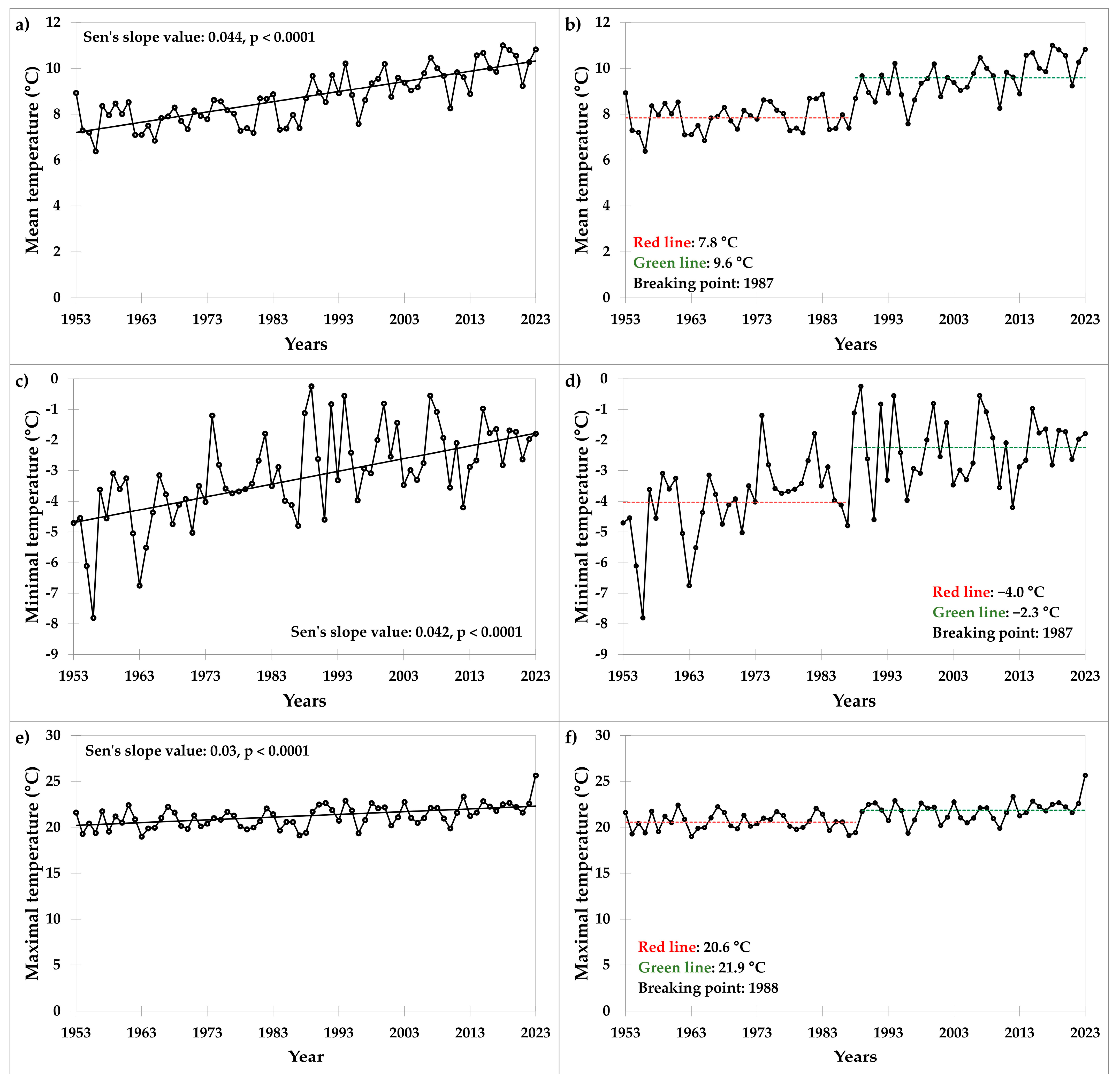


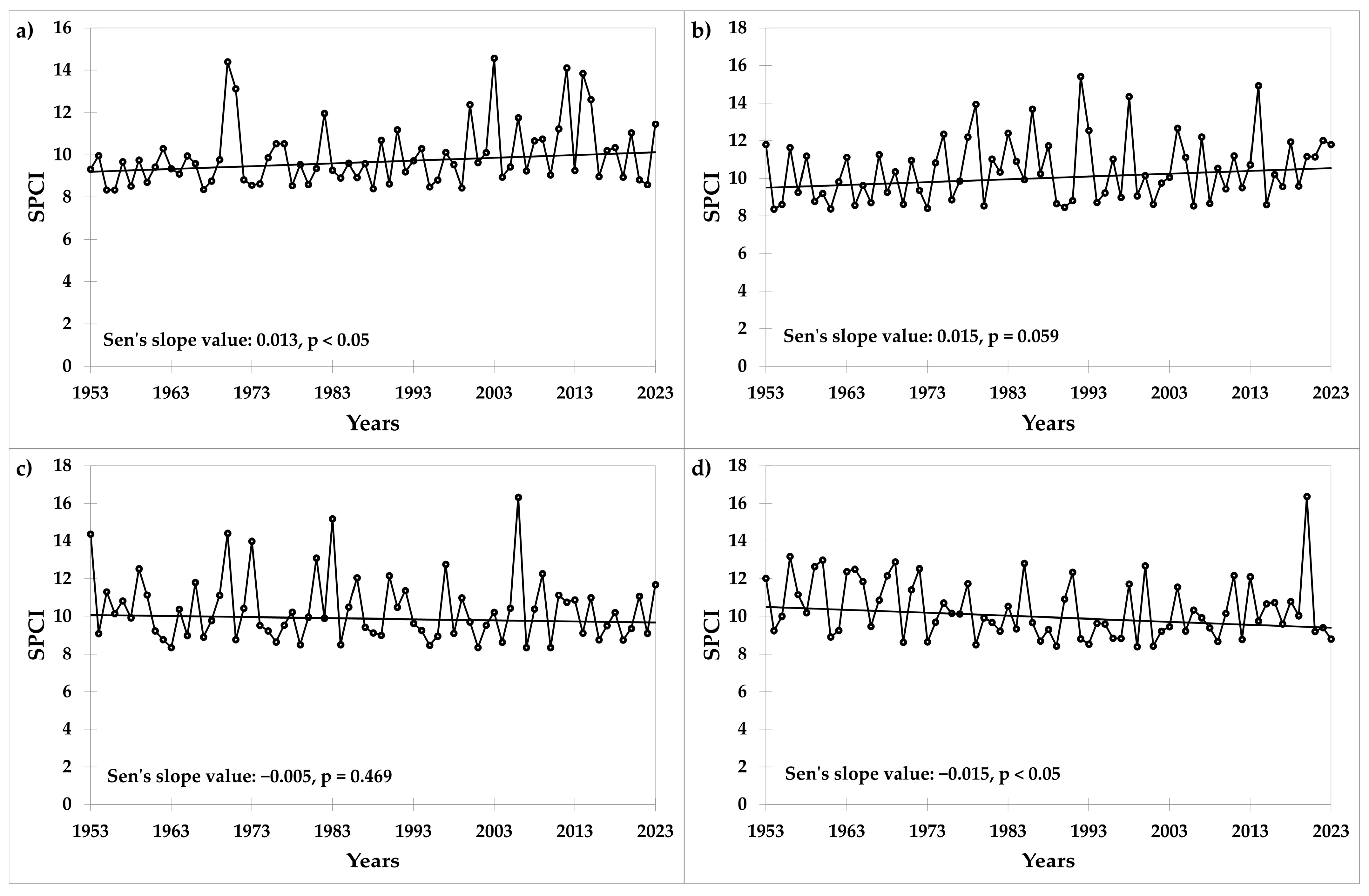
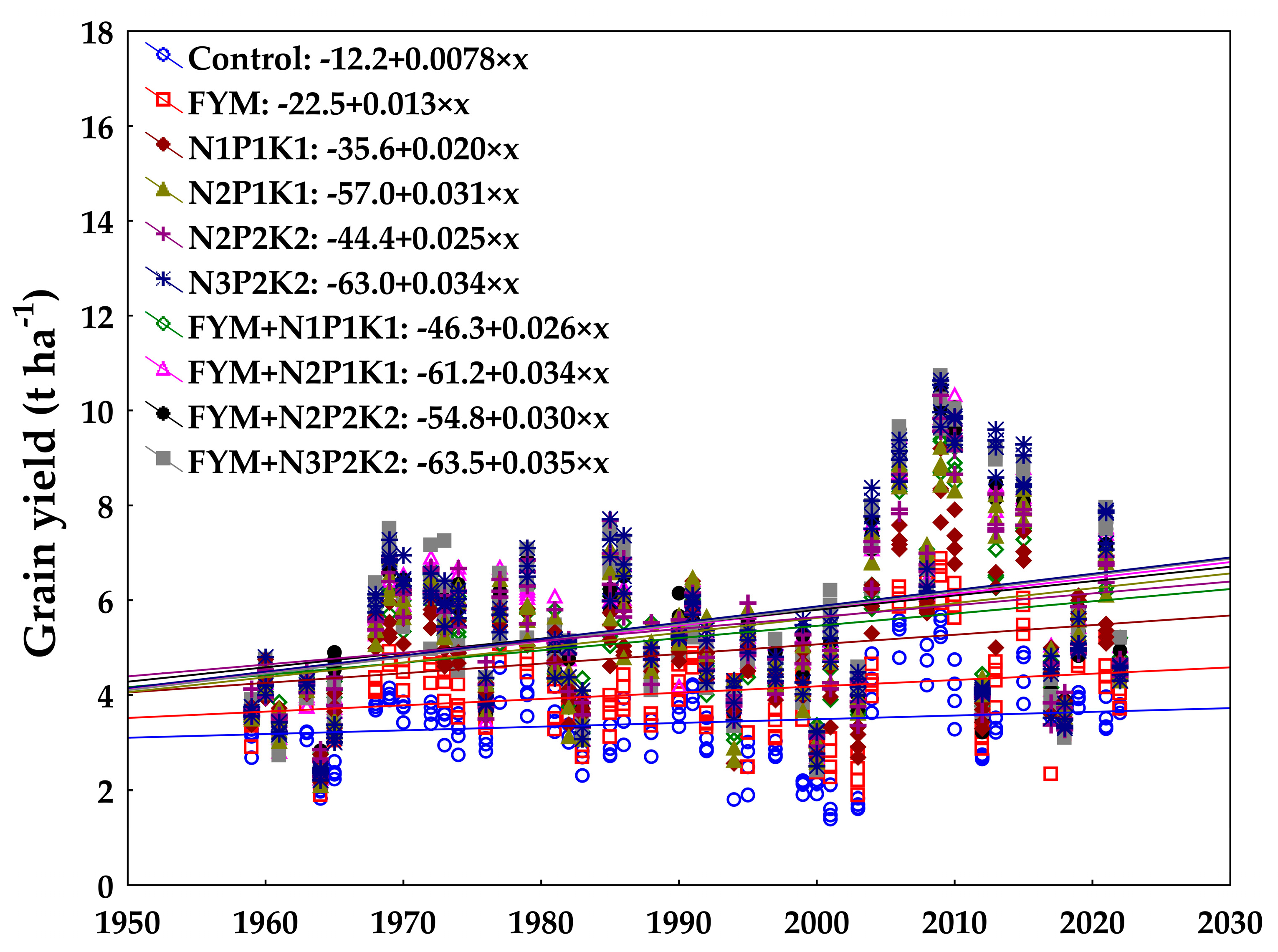
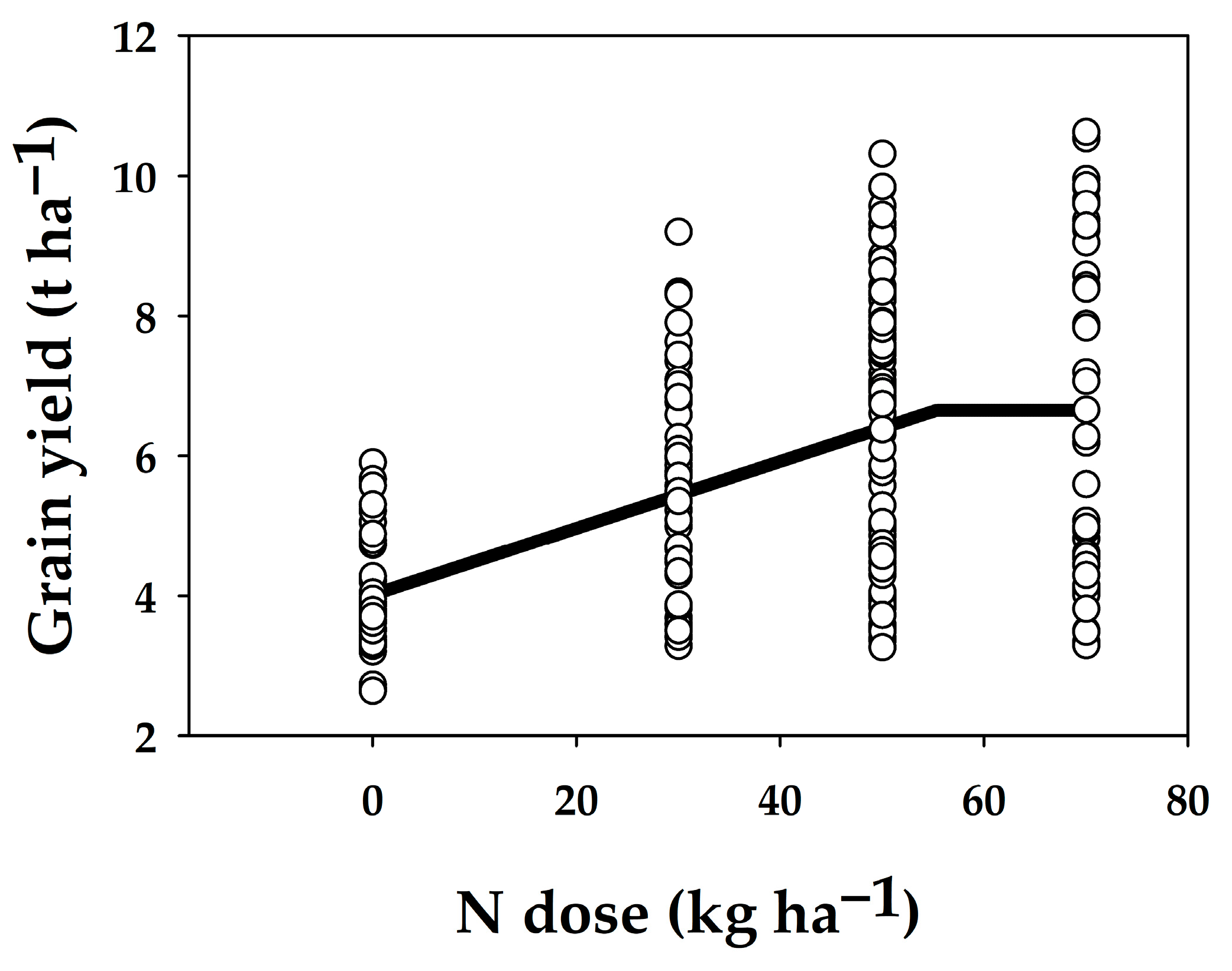
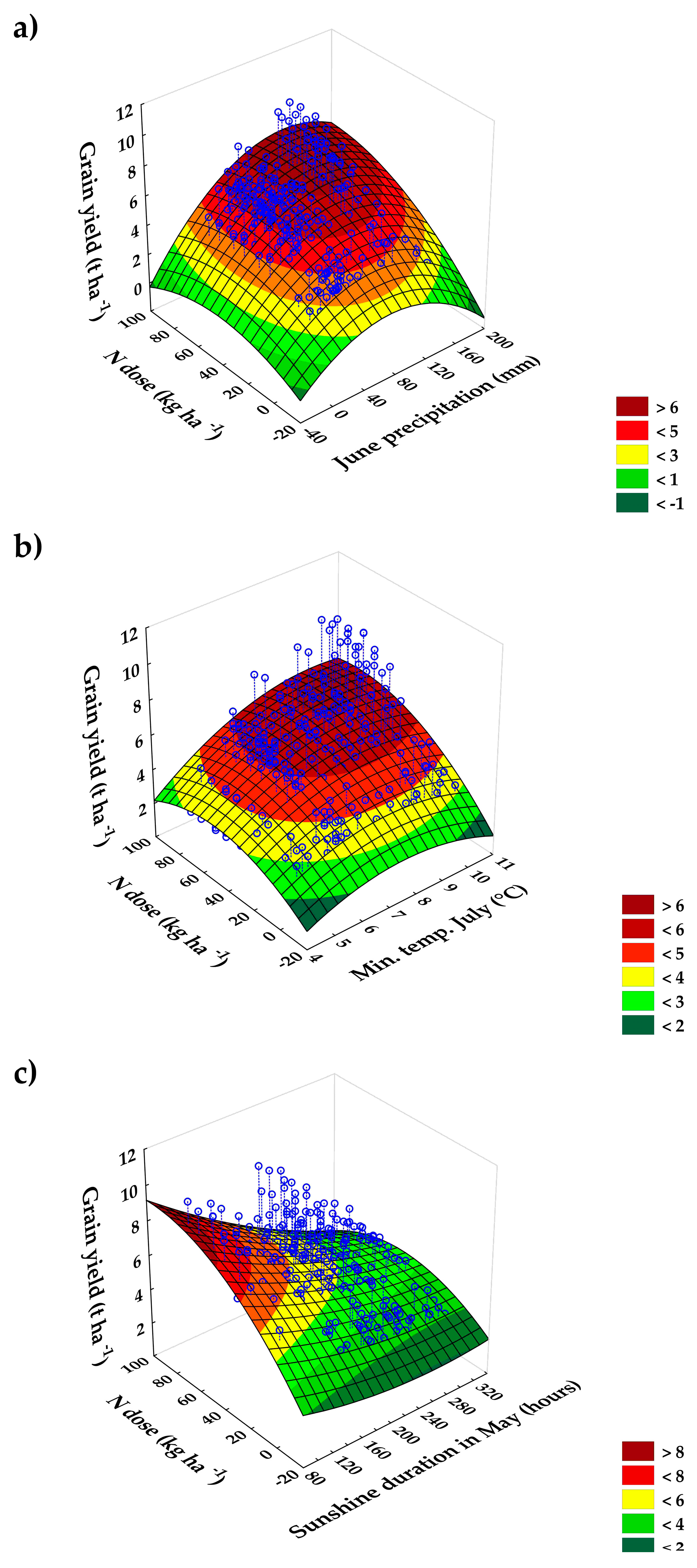
| Mean Temp. | Minimal Temp. | Maximal Temp. | Sunshine Duration | Precipitation | |
|---|---|---|---|---|---|
| Mean temp. | 1 | 0.733 | 0.735 | 0.544 | −0.081 |
| Minimal temp. | 0.733 | 1 | 0.466 | 0.201 | 0.002 |
| Maximal temp. | 0.735 | 0.466 | 1 | 0.547 | −0.273 |
| Sunshine duration | 0.544 | 0.201 | 0.547 | 1 | −0.337 |
| Precipitation | −0.081 | 0.002 | −0.273 | −0.337 | 1 |
| Variety | Mean | Minimum | Maximum |
|---|---|---|---|
| Hanácký Kargyn | 3.7 ± 0.5 AB | 2.7 | 4.8 |
| Branišovický | 3.3 ± 0.9 A | 1.8 | 4.9 |
| Diamant | 5.4 ± 1.1 E | 2.7 | 7.5 |
| Favorit | 4.6 ± 1.1 D | 2.3 | 7.1 |
| Bonus | 5.3 ± 1.1 E | 2.7 | 7.7 |
| Perun | 4.4 ± 0.7 CD | 2.8 | 5.7 |
| Akcent | 4.0 ± 1.0 BC | 1.4 | 6.2 |
| Amulet | 6.5 ± 1.3 F | 3.6 | 8.4 |
| Sebastián | 6.1 ± 2.1 EF | 2.3 | 10.7 |
| Mean | Minimum | Maximum | |
|---|---|---|---|
| Control | 3.4 ± 0.9 A | 1.4 | 5.9 |
| FYM | 4.1 ± 1.0 B | 1.9 | 6.9 |
| N1P1K1 | 4.9 ± 1.3 C | 2.2 | 9.2 |
| N2P1K1 | 5.3 ± 1.6 C | 2.1 | 9.3 |
| N2P2K2 | 5.4 ± 1.6 C | 2.3 | 10.3 |
| N3P2K2 | 5.5 ± 1.9 C | 2.2 | 10.6 |
| FYM+N1P1K1 | 5.2 ± 1.5 C | 2.3 | 9.7 |
| FYM+N2P1K1 | 5.5 ± 1.8 C | 2.2 | 10.3 |
| FYM+N2P2K2 | 5.5 ± 1.8 C | 2.2 | 10.5 |
| FYM+N3P2K2 | 5.5 ± 1.9 C | 2.2 | 10.7 |
| Treatment | N (kg ha−1) | P (kg ha−1) | K (kg ha−1) |
|---|---|---|---|
| Control | 0 | 0 | 0 |
| N1P1K1 | 30 | 21.1 | 66.4 |
| N2P1K1 | 50 | 21.1 | 66.4 |
| N2P2K2 | 50 | 26.4 | 83 |
| N3P2K2 | 70 | 26.4 | 83 |
Disclaimer/Publisher’s Note: The statements, opinions and data contained in all publications are solely those of the individual author(s) and contributor(s) and not of MDPI and/or the editor(s). MDPI and/or the editor(s) disclaim responsibility for any injury to people or property resulting from any ideas, methods, instructions or products referred to in the content. |
© 2024 by the authors. Licensee MDPI, Basel, Switzerland. This article is an open access article distributed under the terms and conditions of the Creative Commons Attribution (CC BY) license (https://creativecommons.org/licenses/by/4.0/).
Share and Cite
Hlisnikovský, L.; Zemanová, V.; Roman, M.; Menšík, L.; Kunzová, E. Long-Term Study of the Effects of Environment, Variety, and Fertilisation on Yield and Stability of Spring Barley Grain. Plants 2024, 13, 2745. https://doi.org/10.3390/plants13192745
Hlisnikovský L, Zemanová V, Roman M, Menšík L, Kunzová E. Long-Term Study of the Effects of Environment, Variety, and Fertilisation on Yield and Stability of Spring Barley Grain. Plants. 2024; 13(19):2745. https://doi.org/10.3390/plants13192745
Chicago/Turabian StyleHlisnikovský, Lukáš, Veronika Zemanová, Muhammad Roman, Ladislav Menšík, and Eva Kunzová. 2024. "Long-Term Study of the Effects of Environment, Variety, and Fertilisation on Yield and Stability of Spring Barley Grain" Plants 13, no. 19: 2745. https://doi.org/10.3390/plants13192745








